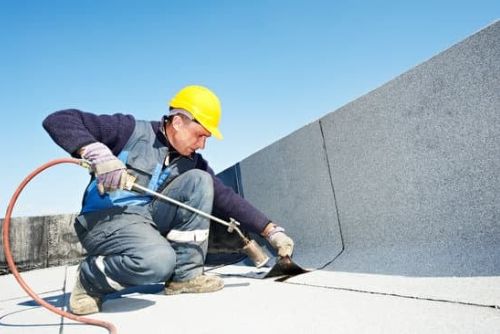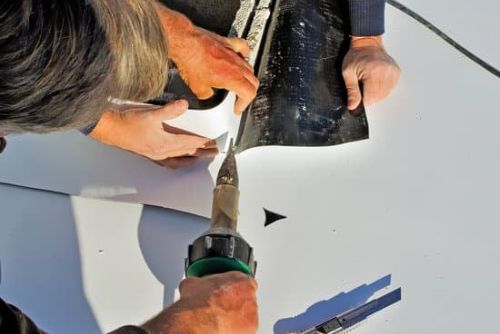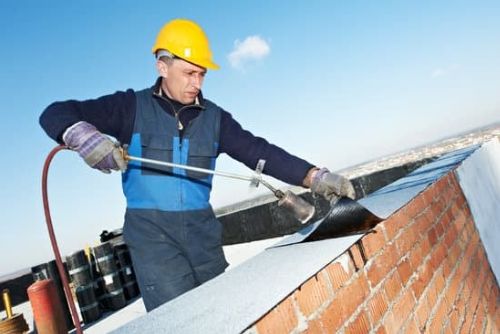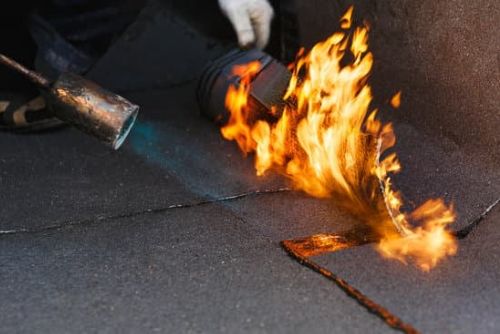What Is TPO Roofing
Need an innovative roofing solution? TPO roofing—what is it and is it right for you? This article discusses TPO roofing, its benefits, and how it works.
Thermoplastic polyolefin (TPO) roofing It's a growing single-ply membrane system that resists fire, wind uplift, puncture, and UV radiation. Additionally, its flexibility makes it easy to install on any structure, regardless of shape or size.
TPO roofing may be the solution if you want a different roof. Explore this exciting product and decide if it's right for you. This article will give you guides and insights on what is TPO roofing.
Overview Of TPO Roofing
TPO roofing is cutting-edge home and business protection. TPO is a single-ply roofing membrane. Due to its affordability, durability, and ease of installation, this material has grown in popularity. TPO roofing is environmentally friendly and provides excellent protection from UV rays, heat, cold, and other weather conditions.
Two layers of TPO roofing are glued together. The bottom layer supports the waterproof top layer. You can pick the right membrane size. Aesthetically, there are many colours.
TPO roofs are cost-effective and weatherproof. They are easy to install and durable. Let's talk about some of these roofs' benefits now.
Benefits Of TPO Roofs
Due to its many benefits, commercial and residential TPO roofing is becoming more popular. TPO roofs can withstand hail, wind, and rain without leaking. Second, they are lightweight and easier to install than other roofing materials. Third, their reflective properties save energy and keep buildings cool in the summer. Finally, TPO membranes come in many colours and styles to match your building's aesthetic.
TPO roofs don't need adhesives or sealants for installation—just screws. If anything happens, it's easy to fix. TPO roofs last longer and cost less because they don't need maintenance or replacement. TPO membrane installation offers these benefits:
- Durable material with superior resistance against extreme weather conditions
- Lightweight design allows for quick installation
- Reflective properties provide excellent insulation from heat gain
- Variety of colors and styles available
TPO roofing is ideal for anyone seeking a durable, affordable, and attractive roof system. With all these benefits, this type of roof is becoming more popular among homeowners and businesses. Let's examine today's TPO membranes.
Different Types Of TPO Membranes

Low-slope roofs benefit from TPO membranes. They seal well and require little maintenance. Single-ply and multi-ply TPO each have benefits.
Single-ply TPO membranes are heat-welded together at the seams to prevent moisture infiltration. This reflective roofing system provides excellent weather protection, UV resistance, and energy savings. Its lightweight design makes installation flexible.
High-frequency welding bonds layers of polyester reinforcement between two sheets of PVC or other synthetic materials in multi-ply TPO systems. These systems are stronger, more durable, and fire-, impact-, and puncture-resistant than single-ply membranes. These systems offer better insulation than single-ply membranes, making them ideal for colder climates.
Both types of TPO membranes provide cost-effective roofing solutions with long-term performance. Proper installation will protect your structure from the elements for years. Let's learn about tile roof installation now.
Installation Of TPO Roofs

TPO roof systems can be mechanically or fully adhered. Full adhesion uses adhesive to attach the membrane to the substrate, while mechanical attachment uses fasteners. Both installation methods require airtight membrane-substrate seals with caulk or tape around seams and flashings.
Insulation boards, vapor retarder membranes, and special coatings that must be applied to the membrane to protect it from sunlight and weather complicate the installation process. In addition to these components, there are several types of roofing membrane edging strips used at corners and edges during installation.
Installers must have TPO roofing experience because even small mistakes can cause major issues. Thus, a long-lasting waterproof solution requires hiring a qualified professional who knows how to install a TPO system.
Advantages And Disadvantages
TPO (thermoplastic polyolefin) is a great roofing option for homes and businesses. This roof is cost-effective and energy-efficient, making it ideal for residential and commercial properties. If you want to know what is TPO roofing, examine these advantages and disadvantages:
- Durability - The material used in a TPO roof is highly durable and resistant against weather damage, fire, punctures, chemicals, and even ultraviolet rays. This helps ensure its long-term performance while reducing maintenance costs over time.
- Flexibility - A TPO roof can be installed quickly due to its lightweight design which also makes it easier to install than other types of roofs. Additionally, the flexibility offered by this material allows it to move with temperature changes without cracking or splitting like traditional membranes do.
- Energy efficiency – When compared to more traditional roof systems such as asphalt shingle roofs, TPO roofs offer better insulation capabilities which helps keep homes cooler during hot summer months and warmer during cold winter months. This not only increases comfort levels but also reduces energy bills significantly.
TPO roofing systems have pros and cons. Their high cost is a drawback. Installation requires specialised tools and knowledge, so an experienced contractor may be needed to achieve the desired results.
While these drawbacks shouldn't deter you from installing a TPO roof if it meets your needs, it's important to consider all options before choosing one. Doing so will help you choose the best roofing system for your property. Maintenance and repair complicate project solution selection.
Maintenance And Repair

After discussing TPO roofing systems' pros and cons, let's discuss maintenance and repair. TPO roofs are low-maintenance. However, you should still check your roof for damage from hail, strong winds, snow, and ice.
When inspecting your TPO roof for repairs, make sure all seams are sealed without gaps or cracks. Direct sunlight can also make your roof membrane brittle and crack. Before further damage occurs, replace the affected sections.
TPO roofs are lightweight and durable, which makes them easier and cheaper to repair than other commercial roofing systems. TPO roofs can last many years without major repairs with proper installation and inspections. Next: TPO roof system cost considerations
Cost Considerations
TPO roofing costs less than other types. Installation could cost $7 to $15 per square foot, depending on roof size and labour costs. This may seem expensive, but many roofs can last 50 years or more with proper maintenance, so investing in quality materials like TPO now will save you money later. TPO's superior insulating properties also lower energy costs. After considering these factors, TPO installation makes financial sense. Let's examine TPO roofing's environmental impact...
Environmental Impact

TPO thermoplastic membrane roof systems are eco-friendly. Their low VOC content reduces air pollution and makes them energy efficient and reflective. Installing TPO membranes without adhesives or sealants reduces emissions. Recycled materials make this roof even more eco-friendly. They are ideal for eco-friendly home or business security.
TPO roofs have many other advantages. These lightweight, durable roofs can last 20 years before needing repair or replacement. The installation process doesn't require reinforcement like concrete or steel beams, saving you labour costs. Since they come in many colours, you can easily match your existing colour scheme.
Overall, TPO thermoplastic membrane roofs protect the environment and save money on installation and repairs. These roofing systems are growing in popularity among homeowners and businesses for good reason. Compare TPO to other roofing systems.
Comparison To Other Roofing Systems
TPO roofing is new, but its affordability and durability have made it popular. TPO roofs outlast asphalt shingles and are cheaper than EPDM rubber membranes. Since they don't need sealing or painting like traditional roofs, they're low-maintenance. TPO roofs are also resistant to extreme temperatures and rain.
EPDM rubber membrane roofs require more maintenance than TPO roofs and cost more upfront. EPDM membranes may not work in extreme temperatures. Asphalt shingles are the cheapest roofing option, but they lack the protection of TPO or EPDM roofs and need to be replaced every few years, depending on weather conditions.
Before choosing a roofing material, consider your budget and how long you'll keep your house. TPO roofs are a good choice for those who want a quality roof without breaking the bank because they last longer and require less maintenance than asphalt shingle roofs. Considering all these factors, discussing heat reflective properties is a natural progression in this discussion about comparing different roofing systems.
Heat Reflective Properties
After comparing TPO roofing to other systems, let's examine its heat reflective properties. TPO roofing reflects 85% of the sun's rays, making it energy efficient. It reduces air conditioning and electricity costs while keeping your home or business cool in hot climates. Tile roofs reflect more light than asphalt shingle roofs, making rooms brighter during the day.
TPO roofing also insulates buildings, providing year-round thermal protection. This type of roof will help you maintain comfortable temperatures year-round without using additional heating or cooling by trapping warm air inside in the winter and cooler air outside in the summer. Eco-conscious homeowners will save money on utilities and energy consumption with it.
TPO roofing's many benefits make it popular among builders and property owners. Let's compare EPDM and TPO roofing.
EPDM Vs TPO Roofing
Thermoplastic polyolefin (TPO) roofing is a single-ply membrane. Its durability and energy efficiency make it one of the most popular commercial roofing systems. TPO roofing benefits include:
- Energy Efficiency - TPO roofs reflect the sun’s rays back into the atmosphere, reducing cooling costs in warm climates.
- Durability - The material resists damage due to wind, hail, UV radiation and extreme temperatures without cracking or deteriorating over time.
- Versatility - Available in multiple colors and thicknesses, TPO membranes can be easily customized for any size building project.
- Cost Effective – Installation costs less than traditional built-up and modified bitumen systems.
- Eco-Friendly – Containing no chlorine or plasticizers, these roofs have a low environmental impact.
Another single-ply membrane used for decades in commercial roofing is EPDM (ethylene propylene diene monomer). EPDM may not be as energy efficient as TPO, but it has better fire safety ratings, making it ideal for buildings near hospitals and schools. EPDM sheets come in more sizes and colours than TPO, making them easier to install on large projects like shopping malls and apartment complexes. EPDM costs less than TPO but may need more maintenance due to weather damage.
The advantages of these two single-ply membranes can make choosing between them difficult. Both offer excellent moisture protection and can withstand long periods of ultraviolet light without wearing down, making them ideal for any flat roof structure, whether residential or commercial. As we explore fire safety ratings, let's keep an open mind about how our choice will affect our budget and installation sustainability.
Fire Safety Ratings

Fire safety ratings follow EPDM and TPO roofing materials. Local building codes require fire-resistant commercial roofs. Most commercial roofing materials are fire-resistant. Metal or concrete tile roofs offer greater flame retardancy than asphalt shingle roofs. Many manufacturers also offer special coatings to protect these roofs from fire.
TPO and EPDM rubber membrane roofs are naturally flame retardant, but building codes may require additional treatments or coatings. Property owners and developers should consult their local municipality before starting any new construction project using either of these roofing materials to ensure compliance with fire safety regulations.
When installing a new commercial roof, consider the material's initial cost and long-term durability and lifespan. Doing so helps you choose a roof that meets your needs and budget now and in the future.
Durability And Lifespan
TPO roofing is long-lasting. TPO single-ply membranes can withstand extreme temperatures, UV rays, and wind uplift forces. They are ideal for extreme weather. TPO made from polypropylene and ethylene-propylene copolymer resins resists fire, chemicals, grease, oil, and other harsh environments that damage traditional roofing materials.
TPO roofs' lifespans depend on climate and maintenance. However, a well-maintained TPO roof can last 15–20 years or more. A professional contractor will inspect your TPO roof regularly to keep it functional throughout its lifespan, adding value to this affordable option.
TPO roofs typically come with 25-year warranties and guarantees when professionally installed. This added protection protects your investment and covers system issues.
Warranties And Guarantees
Due to its durability, affordability, and ease of installation, TPO roofing is becoming more popular for commercial roofs. Understanding TPO roof warranties and guarantees is crucial when choosing a roofing material. Here are four key points about warranties and guarantees for TPO roofs:
- Most manufacturers offer limited lifetime warranties on their product which covers defects in the material or workmanship that may occur during the install process.
- Many companies will also guarantee the seams created by welding two pieces together, providing additional peace of mind should they become damaged over time.
- While most types of roofs have standard warranty coverage, some manufacturers may provide different levels depending on the type of TPO roof chosen; be sure to ask your contractor before making a purchase decision.
- Lastly, keep in mind that while these warranties cover materials and labor costs related to repairing or replacing defective items, they do not usually include damages caused by weather events such as hail storms or high winds.
Understanding the warranty or guarantee for a TPO roof on your commercial building is crucial to long-term satisfaction. With this knowledge, you can start researching roof financing options.
Finance Options

TPO roofing installation requires financing. Today's innovative roofing materials and products require multiple funding options for success. It's crucial to consider all your financing options before choosing one.
Home equity loans or lines of credit can help homeowners finance TPO roofing projects. These loans let borrowers use their homes as collateral. Leveraging this asset often yields better interest rates than banks or credit unions. They are ideal for financing a new roof.
Government grants and subsidies help cover TPO installation costs. State and local organizations may offer funding for roofing upgrades or repairs, depending on where you live. These resources offer no-interest payment plans that make large purchases more manageable.
Researching your TPO installation financing options will help you find a plan that fits your budget and future needs.
Final Thoughts
TPO roofing is a great choice for roof replacement. Its 30-year lifespan and low maintenance make it a cost-effective option. Installing this roof also offers tax incentives, so you can save money and help the environment. If that doesn't convince you, consider TPO roofing's fire resistance. TPO roofing offers durability, affordability, and environmental friendliness. By now, you already know what is TPO roofing and its pros and cons.
FAQs
What Is The Expected Lifespan Of A TPO Roof?
TPO roof lifespan? It's crucial when choosing this roof for your home. Technology has made TPO roofs more popular and reliable, but how long will they last? Let's examine how long these roofs last and what factors affect their durability.
TPO roof warranties can estimate lifespans. Depending on installation and material quality, warranties last 10–20 years. However, other external factors may affect the TPO roof's lifespan. Hail storms and extreme temperatures can crack or puncture the membrane, shortening its lifespan. To prevent wind and rain damage, it should be maintained every few years.
TPO roofs can last 15–30 years with proper installation and maintenance. Investing in a new roof can be overwhelming, but using energy-efficient materials like TPO membranes can save money on summer cooling costs. Why wait? TPO roofs are a durable option for today's homeowners.
Are There Any Maintenance Requirements For A TPO Roof?
TPO roof maintenance? Absolutely. Regular inspections and preventive maintenance are essential for all roofs. The frequency of these inspections depends on your climate. Check for cracks, blisters, tears, punctures, and UV degradation as part of regular maintenance. For proper water drainage, keep gutters and downspouts clean.
Watch for excessive foot traffic on the roof. Walking across it without protection can prematurely age or damage it. If personnel or equipment frequently access your TPO roof, install walkways with guardrails. This ensures membrane integrity and safe passage.
Following these simple steps and having routine inspections by a qualified professional every few years (depending on local code) can extend the life of your TPO roofing system, allowing you to enjoy its superior performance with peace of mind.
Are There Any Tax Incentives For Installing A TPO Roof?
TPO roofs for homes and businesses? Understand tax incentives before investing. By maximising your roof's value, you can save money.
TPO roofs are energy-efficient and tax-saving when properly installed. If you choose this roofing material, local governments may offer tax credits or other incentives. Materials and installation practices can also qualify businesses for federal deductions.
To maximise TPO roof benefits, you must know which incentives apply to your situation. You should also research local installation timing and cost limits that affect these incentives. Researching now will give you more financial freedom later.
Is TPO Roofing More Expensive Than Other Types Of Roofs?
Choosing a roof material is crucial. How much does TPO roofing cost?
TPO roofing may cost more depending on its size and complexity. Choosing a roof type may not be based solely on cost. TPO roofing's durability, energy efficiency, and versatility make it a good investment, especially in areas with extreme weather or heavy snowfall.
Before choosing a roof, check for tax incentives. Quality materials will protect and last your home.
Are TPO Roofs Fire Resistant?
Roofs must be fire-resistant. TPO roofing provides peace of mind against fires. This fire-safe roofing material is ideal for homeowners.
Heat-welded layers of TPO roofing create a fire-resistant barrier. Flames and high temperatures are shielded by the top layer. In some climates, it keeps moisture out, preventing mold growth. This top layer also reflects infrared radiation, keeping your home cooler in the summer.
TPO roofing is a reliable, safe, and affordable way to protect your home from fires. Its durability and protection make it worth the investment. Since its installation is simpler than other roofs, more people are using this great product every day.